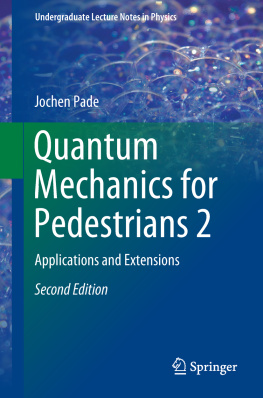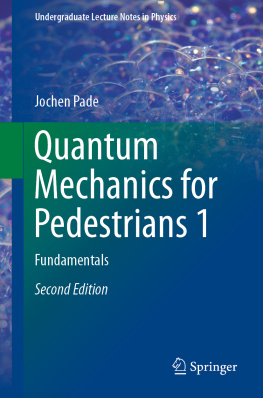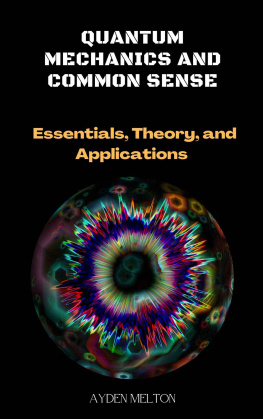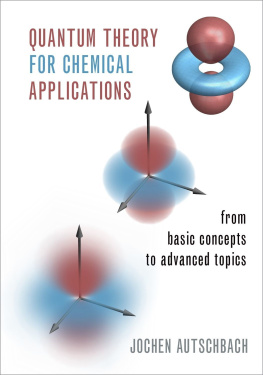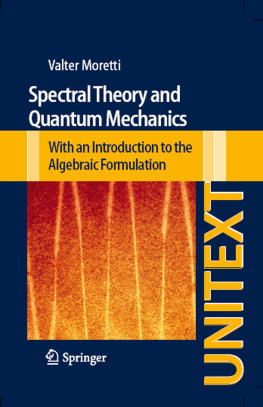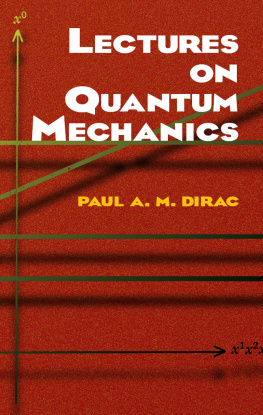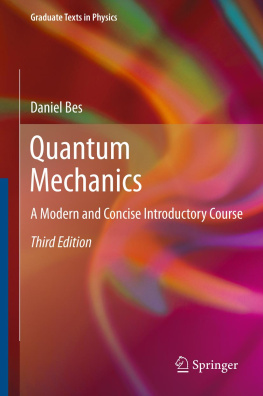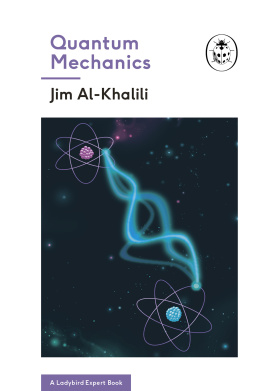Jochen Pade - Quantum Mechanics for Pedestrians 2
Here you can read online Jochen Pade - Quantum Mechanics for Pedestrians 2 full text of the book (entire story) in english for free. Download pdf and epub, get meaning, cover and reviews about this ebook. year: 0, publisher: Springer International Publishing, genre: Children. Description of the work, (preface) as well as reviews are available. Best literature library LitArk.com created for fans of good reading and offers a wide selection of genres:
Romance novel
Science fiction
Adventure
Detective
Science
History
Home and family
Prose
Art
Politics
Computer
Non-fiction
Religion
Business
Children
Humor
Choose a favorite category and find really read worthwhile books. Enjoy immersion in the world of imagination, feel the emotions of the characters or learn something new for yourself, make an fascinating discovery.
- Book:Quantum Mechanics for Pedestrians 2
- Author:
- Publisher:Springer International Publishing
- Genre:
- Year:0
- Rating:4 / 5
- Favourites:Add to favourites
- Your mark:
- 80
- 1
- 2
- 3
- 4
- 5
Quantum Mechanics for Pedestrians 2: summary, description and annotation
We offer to read an annotation, description, summary or preface (depends on what the author of the book "Quantum Mechanics for Pedestrians 2" wrote himself). If you haven't found the necessary information about the book — write in the comments, we will try to find it.
Quantum Mechanics for Pedestrians 2 — read online for free the complete book (whole text) full work
Below is the text of the book, divided by pages. System saving the place of the last page read, allows you to conveniently read the book "Quantum Mechanics for Pedestrians 2" online for free, without having to search again every time where you left off. Put a bookmark, and you can go to the page where you finished reading at any time.
Font size:
Interval:
Bookmark:
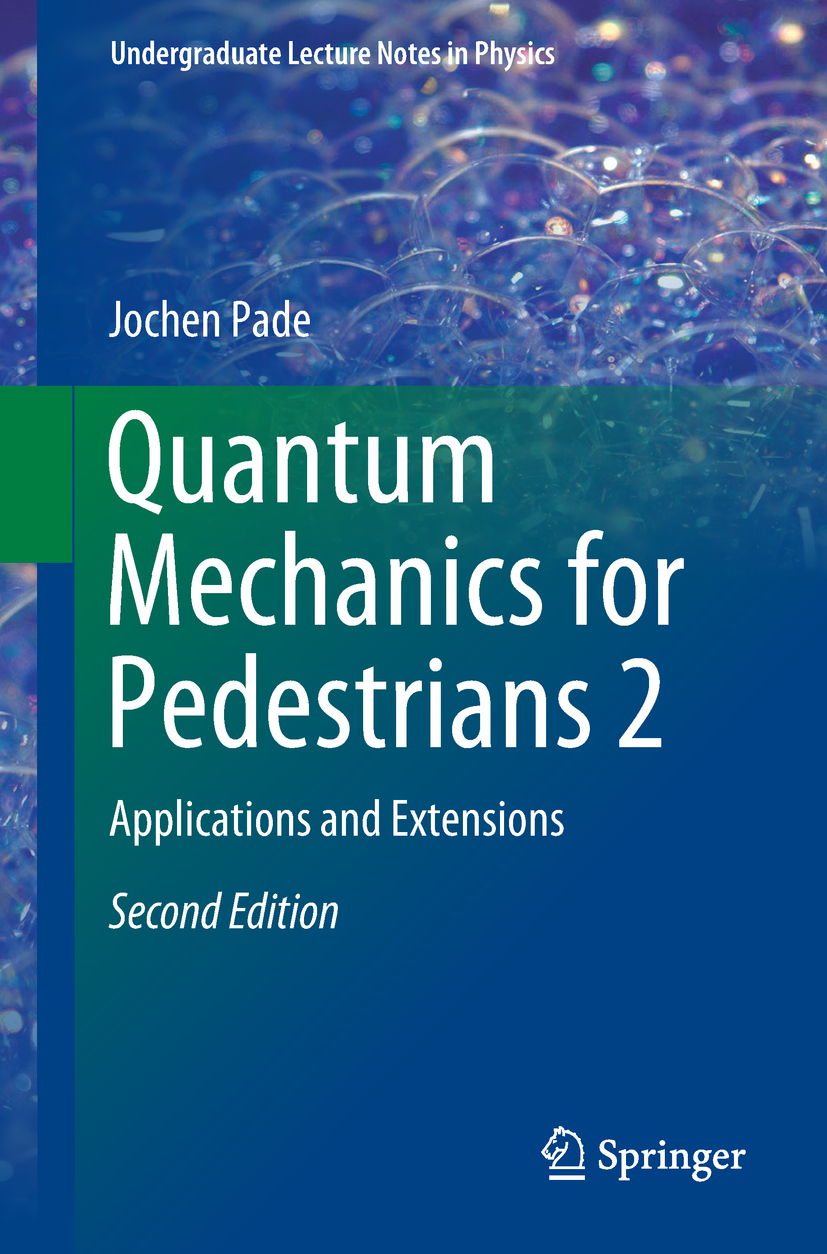
Undergraduate Lecture Notes in Physics (ULNP) publishes authoritative texts covering topics throughout pure and applied physics. Each title in the series is suitable as a basis for undergraduate instruction, typically containing practice problems, worked examples, chapter summaries, and suggestions for further reading.
An exceptionally clear and concise treatment of a standard undergraduate subject.
A solid undergraduate-level introduction to a graduate, advanced, or non-standard subject.
A novel perspective or an unusual approach to teaching a subject.
ULNP especially encourages new, original, and idiosyncratic approaches to physics teaching at the undergraduate level.
The purpose of ULNP is to provide intriguing, absorbing books that will continue to be the readers preferred reference throughout their academic career.
More information about this series at http://www.springer.com/series/8917

This Springer imprint is published by the registered company Springer Nature Switzerland AG
The registered company address is: Gewerbestrasse 11, 6330 Cham, Switzerland
In this second edition of Volume 2, a short introduction to the basics of quantum field theory has been added. The material is placed in the Appendix. It is not a comprehensive and complete presentation of the topic, but, in the sense of a primer, a concise account of some of the essential ideas.
Fundamentals from other areas can be found in Volume 1, i.e., outlines of special relativity, classical field theory, electrodynamics and relativistic quantum mechanics.
In the first volume of Quantum Mechanics for Pedestrians, we worked out the basic structure of quantum mechanics (QM) and summarized it in the form of postulates that provided its framework.
In this second volume, we want to fill that framework with life. To this end, in eight of the 14 chapters we will discuss some key applications, what might be called the traditional subjects of quantum mechanics: simple potentials, angular momentum, perturbation theory, symmetries, identical particles, and scattering.
At the same time, we want to prudently broaden the scope of our treatment, in order to be able to discuss modern developments such as entanglement and decoherence. We begin this theme in Chap..
Finally, we outline in Chap. the most common current interpretations of quantum mechanics. Apart from one chapter, what was said in Volume I applies generally: An introduction to quantum mechanics has to take a definite stand on the interpretation question, although (or perhaps because) the question as to which one of the current interpretations (if any) is the correct one it is still quite controversial. We have taken as our basis what is often called the standard interpretation.
In order to formulate the postulates, we worked in the first volume with very simple models, essentially toy models. This is of course not possible for some of the real systems presented in the present volume, and accordingly, these chapters are formally more complex. However, here also, we have kept the mathematical level as simple as possible. Moreover, we always choose that particular presentation which is best adapted to the question at hand, and we maintain the relaxed approach to mathematics which is usual in physics.
This volume is also accompanied by an extensive appendix. It contains some information on mathematical issues, but its principal focus is on physical topics whose consideration or detailed discussion would be beyond the scope of the main text in Chaps..
In addition, there is for nearly every chapter a variety of exercises; solutions to most of them are given in the appendix.
Quantum mechanics is probably the most accurately verified physical theory existing today. To date, there has been no contradiction from any experiments; the applications of quantum mechanics have changed our world right up to aspects of our everyday life. There is no doubt that quantum mechanics functionsit is indeed extremely successful. On a formal level, it is clearly unambiguous and consistent and (certainly not unimportant)as a theoryit is both aesthetically satisfying and convincing.
The question in dispute is the real meaning of quantum mechanics. What does the wavefunction stand for, and what is the role of chance? Do we actually have to throw overboard our classical and familiar conceptions of reality? Despite the nearly century-long history of quantum mechanics, fundamental questions of this kind are still unresolved and are currently being discussed in a lively and controversial manner. There are two contrasting positions (along with many intermediate views): Some see quantum mechanics simply as the precursor stage of the true theory (although eminently functional); others see it as a valid, fundamental theory itself.
Font size:
Interval:
Bookmark:
Similar books «Quantum Mechanics for Pedestrians 2»
Look at similar books to Quantum Mechanics for Pedestrians 2. We have selected literature similar in name and meaning in the hope of providing readers with more options to find new, interesting, not yet read works.
Discussion, reviews of the book Quantum Mechanics for Pedestrians 2 and just readers' own opinions. Leave your comments, write what you think about the work, its meaning or the main characters. Specify what exactly you liked and what you didn't like, and why you think so.

